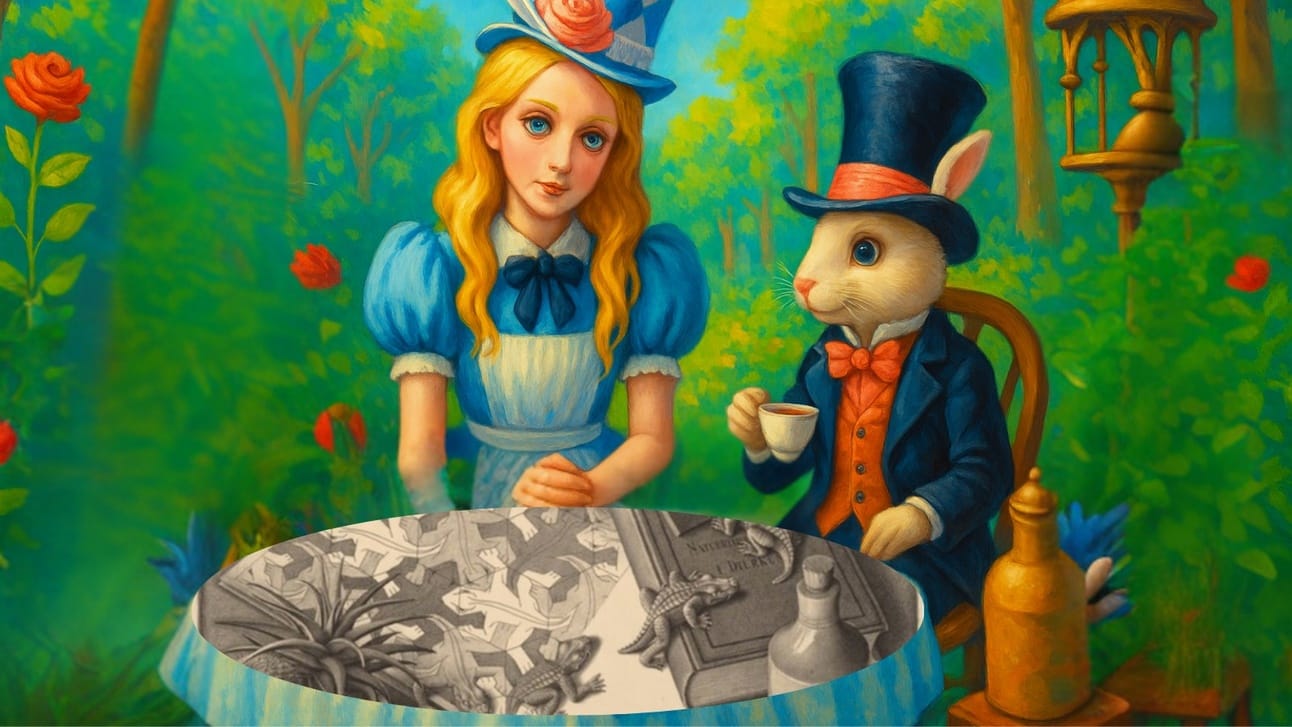- Kreatio
- Posts
- The Art of Impossible Ideas
The Art of Impossible Ideas
What seems impossible often just requires the courage to defy convention.

INSPIRING QUOTE
Wonder Before Breakfast
“I dare say you haven’t had much practice,” said the Queen. “When I was your age, I always did it for half an hour a day. Why, sometimes I’ve believed as many as six impossible things before breakfast.”
This iconic quote from the whimsical world of Wonderland invites us to embrace the art of believing in the impossible. It's a reminder that creativity and innovation often begin with willingness to challenge conventional wisdom and to imagine beyond the ordinary.
🧠 Remember, the most groundbreaking ideas often emerge from the space where reality meets imagination.

CREATIVITY SPOTLIGHT

M.C. Escher’s ‘Reptiles’ (1943) shows 2D reptiles transforming into 3D, and vice versa, in an endless cycle.
What the History of Drawing Foretells for the Future of Writing
About 18,000 years ago, men ventured into a dark, damp cave in France known today as the Lascaux cave. They scurried on their stomachs through a tunnel barely wide enough for their bodies and then risked their lives by somehow descending straight down an 18-foot vertical shaft.
But why?
What was so important about the figurative art they drew on the walls of the cave’s deepest chamber?
🌌 Into the Depths of Imagination
The earliest known figurative art from Indonesia is thought to be over 50,000 years old. As a side note, it’s fair to assume that figurative art was first produced in Africa, where modern humans first evolved. Regardless, the first cave art masterpieces show humanity’s first symbolic and representational impulses. But these representations are all two-dimensional and lack any consistent attempt to depict three-dimensionality.
 Hall of the Bulls in the Lascaux Cave (France) |  A bull in the Lubang Jeriji Saleh Cave (Indonesia) |
Decades, centuries, millennia passed, yet our species never showed the ingenuity to innovate in art by moving beyond 2D perspective to 3D. We can imagine people thinking art, older than the wheel, was impossible to innovate.
🖼️ The Long Plateau of Flat Art
Finally after 45,000 years, ancient civilizations like Mesopotamia and Egypt experimented with spatial arrangements. But even these were rudimentary and not showing true geometric perspective.
Interestingly, it was right about this time that writing, as a fully developed system capable of recording language, arose in Mesopotamia.
Soon (quote-unquote) things accelerated. In 7th century CE China, landscape painters used atmospheric perspective, a method that creates illusion of depth by using color, value, and clarity of objects to suggest depth.
Eventually, linear perspective arose as a revolutionary innovation of the Early Renaissance in Italy (~1400s CE), thanks largely to Filippo Brunelleschi and Leon Battista Alberti. Linear perspective was truly creative in many ways and applied a mathematical framework to art, developing a systematic method for representing 3D space on flat surfaces.
“A man can do all things if he but wills them.”
— Leon Battista Alberti believed the impossible was possible.
✍️ From Drawing to Writing to What’s Next?
So, systematic 3D perspective in art took almost 50,000 years to develop! (Or ~45,000 years if you believe it existed earlier in Egypt.) That’s a very long time to go from 2D to 3D, considering what other leaps and bounds occurred during that same time frame.
Today, writing is only 5,000 years young. Just as artists once couldn’t imagine drawing in 3D, maybe we haven’t yet imagined the full dimensionality of writing. What kind of new perspectives might a different way of writing evoke in people?
“Wait,” you say, “What the heck do you mean by a “different way of writing”?”
I don’t know. Then again, our ancestors 50,000 years ago probably also asked, “What the heck do you mean by a different way of drawing?”
“That’s impossible,” some may say today. “There’s no innovation to be done in writing.”
🔄 The Myth of Limits
There are all types of ideas and things that are considered impossible. One category consists of technologically advanced concepts like time travel. But another, ironically, consists of innovating the mundane. So, when someone uses the metaphor that it’s “impossible to reinvent the wheel” even if it’s good sense, it’s likely a bad opinion.
🎨 Drawing’s long arc reminds us that even in the most creative domains, some breakthroughs take many millennia of gradual evolution before a leap occurs. What does that suggest about other domains?
🚀 If you're itching to do what others haven't done before, then dare yourself to innovate… which starts with an impossible idea.

BLINKS, THINKS & LINKS

Curiosity Candy
Check out this virtual tour of Lascaux Cave! And, yes, near the end it shows the 18-foot descent!
How is Filippo not a Teenage Mutant Ninja Turtle?! Check out Brunelleschi’s short biography; this guy deserves your attention.
Beyond developing linear perspective, Brunelleschi led and finished the construction of the Florence Cathedral amongst many other achievements.

ACTIONABLE PROMPTS

Brainstorm Impossible Ideas
Here’s a creative exercise for the week:
🕐 Spend five minutes per day no matter how many days it takes, thinking of three impossible things. Better if the ideas are inspired and related to your life, family, friends, career, hobbies, charity, etc.
🔄 In future sessions think of how you can execute each of the three things.
E.g., How could folding laundry cause world peace?
✨ Keep thinking,
keep dreaming,
but whatever you do, don’t ever stop.
